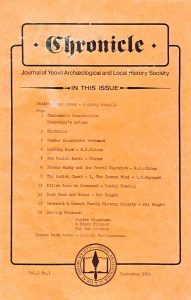1978-Sep-pg11-12_Pillow-Lace in Somerset
This article came from the Chronicle published September 1978. Pages 11-12
PILLOW-LACE
IN SOMERSET
Author: Isabel Rendell
Isabel Rendell
The fame of Devon’s Honiton lace has quite overshadowed the pillow-lace industry of Somerset, But undoubtedly Somerset was one of the early lace-making counties, for in 1669 Cosimo de Medici, a descendant of the great Cosimo, visited the West Country and recorded that ‘There was not a cottage in all the county (i.e. Devon) nor that of Somerset where white lace is not made in great quantities (cf Exeter. MuseumS Publication No.55, Honiton Lace by Pamela Inder, p.2).
Fifty years earlier Mrs Barbara Gaylard of Montacute had apprenticed her two daughters for one year to Mrs Joan Harvey of Yeovil to be taught bone-lace making. They were to receive 2s 6d per week for their maintenance while they were learning their trade, but of course. Mrs Harvey would expect to make a profit from lace made by the two girls as their skill Improved. Their mother, however, had other ideas, and as soon, as the children began to make lace that was good enough to sell she broke the agreement and took them home. Whereupon, in 1620, Mrs Harvey petitioned the Court at Yeovil for redress against the Gaylard family, as the Quarter Sessions Records for Somerset show.
The Victoria County History of Somerset (Vol.2) which tells the story, also mentions, quoting from ‘Rural Elegance Displayed’ 1798, that lace-making was an industry of Wells, while Wood, in his ‘Descriptive Essay on Bath’, speaks of ‘Bath Lace’ which though actually made in Devon, was designed by draughtsmen in Bath ‘whose work was so greatly sought after that one manufacturer was said to have spent as much as £70 in year merely writing for the same’. The lace was then sold in Bath and prices ranged from 1s 6d for small edgings to 3 guineas a yard for fine, broad varieties.
Taunton, also, was a centre of lace-making, for in November 1828 ‘The Globe’ reported that a lace manufactory employing 2,000 hands had been erected by Mr Cox. By 1831 he had done so well that he had taken a partner a Mr Winter, according to Pigot’s Directory which also lists another lace manufactory, George Rawlinson & Co of Taunton. The 1348 Directory of Hunt & Co gives two lace manufacturers, William Rawlinson of East Street and Tancred Street (perhaps a son of George?) and a Henry Sansome of Staplegrove Road, but no Cox or Winter, One has to ask whether these ‘lace manufacturers’ were making machine- or hand-made lace – and the probable answer is both, since Henry Sansome, at any rate, specialized in Honiton lace which cannot be successfully copied by machine. The term ‘manufactory’ was used on lace-tokens of the 18th century when the ‘manufacturers’ farmed out the lace making to the cottage workers who made it by hand, receiving a mere pittance for their labour. The finished product, was then collected by the ‘manufacturer’ who retailed it in London and other large cities at considerable profit to himself. It would be an easy step to collect his lace-workers together in one building in a town like Taunton. But at Chard from 1830 to the early 20th century the lace-mills were making machine-made lace nets, not pillow-lace.
In 1902 the Taunton Honiton Lace Class was established under the auspices of the Taunton School of Art and lasted for about, eight years. ‘The Studio’ of September 1903 speaks of the ‘uniformly good production of the Taunton School’, and the two tutors, Mrs Mason and Miss Harmnett, both won high awards for their lace and designs in national exhibitions in the first decade of this century.
In the Wells Museum, in their country kitchen, is displayed a lace-pillow from Clevedon. It contains a strip of bobbin-lace (Torchon design) made of flax thread and the wooden bobbins are weighted with blue and yellow beads – the probable date of the pillow is late l9th or early 20th century. It is probable that lace-making in Somerset started, as it, did in Devon, with the influx of Protestant refugees from France and the Low Countries in the latter half of the 16th century, but further research needs to be done to prove the origin and extent of the Somerset lace industry.
My thanks are due to Somerset and Dorset Notes and Queries for allowing me to reprint some of these items from the March 1973 number and to the correspondent who sent me further items in response to that query.
